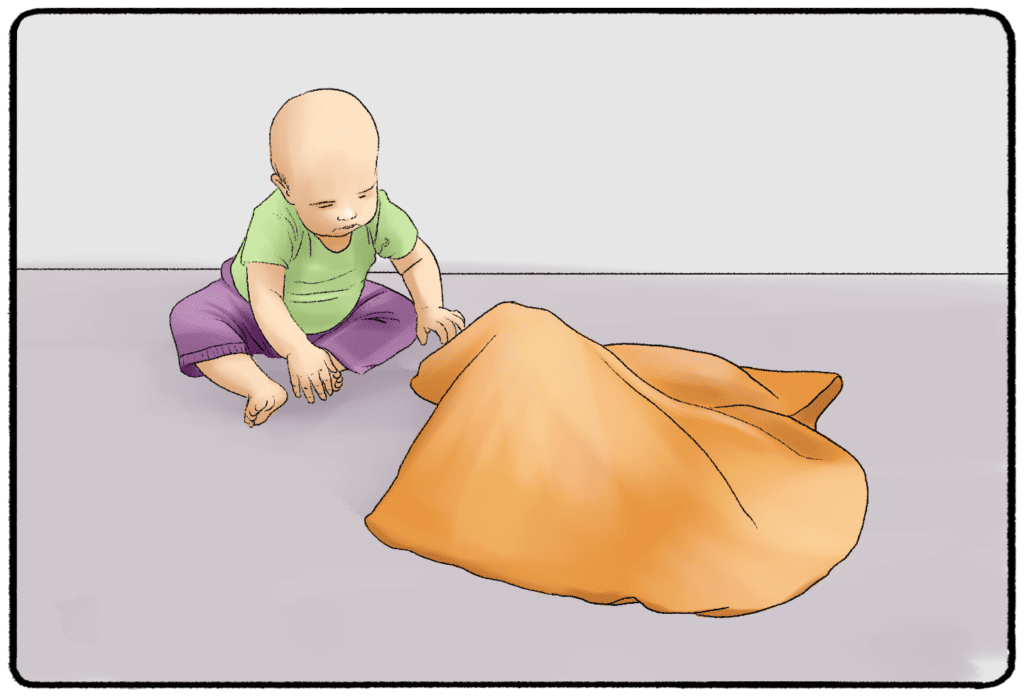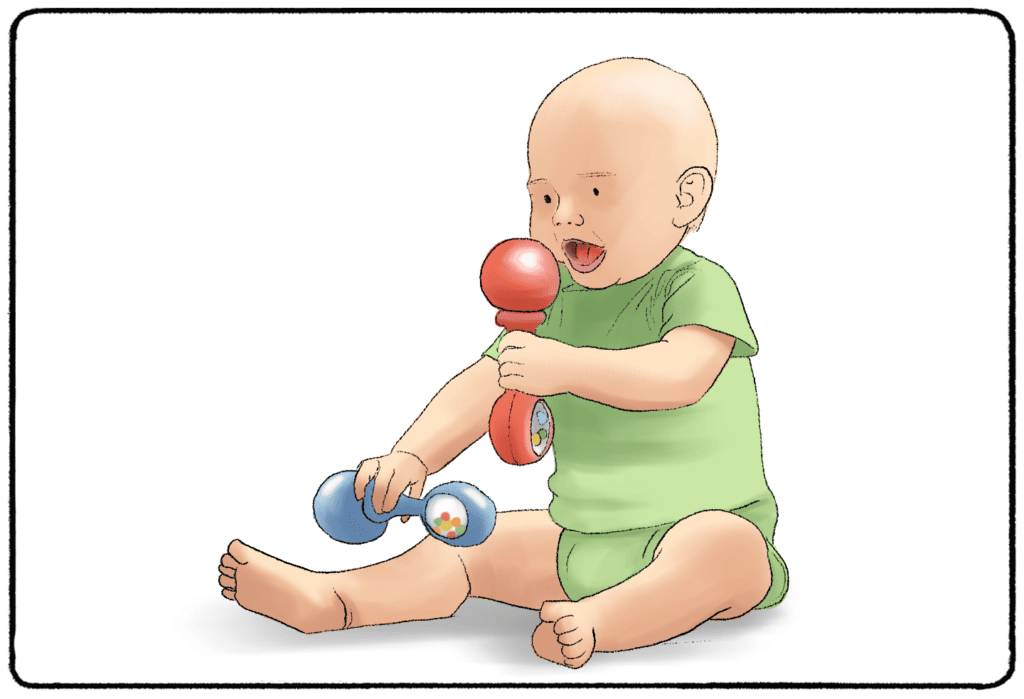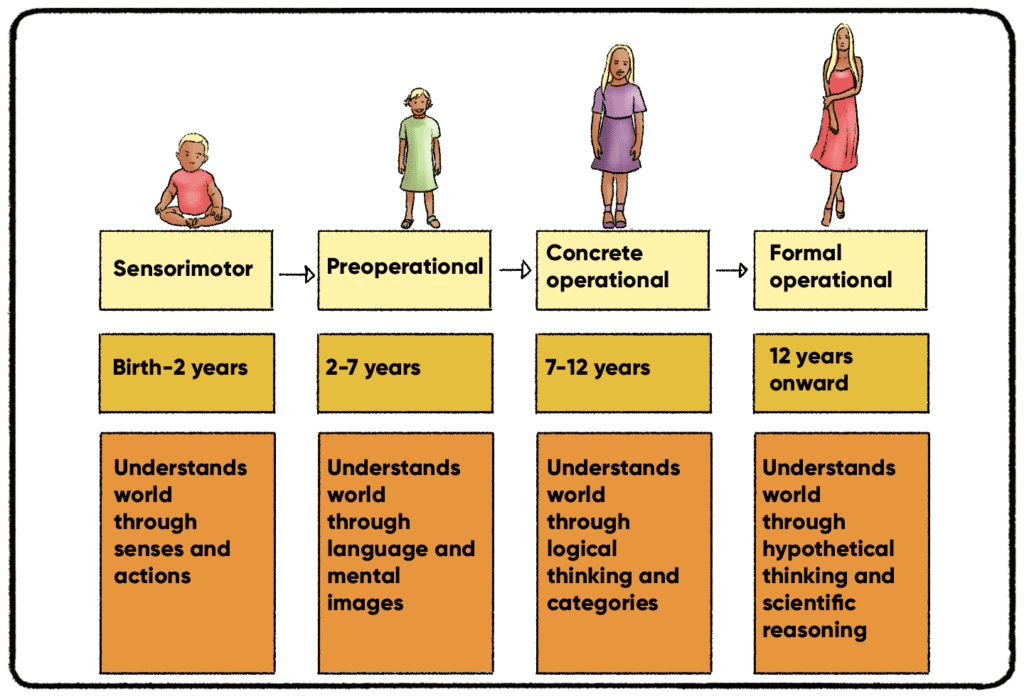We can all agree that babies don’t know how to do a lot. But they grow fast. If you’ve ever cared for an infant or a 1-year-old, you see how fast they develop and learn how to crawl, walk, and take in the world around them.
What Is the Sensorimotor Stage?
From birth to age 2, babies are in the sensorimotor stage of cognitive development. This stage is the first of four stages in Jean Piaget’s Theory of Cognitive Development. The sensorimotor stage has six substages within this one stage.

Ready? Let’s get started by talking about object permanence.
Object Permanence
Before we break down the six substages of the sensorimotor stage, let's discuss object permanence. If you only take away one thing from this video, it should be the concept of object permanence and the idea that it develops during this initial stage of cognitive development.
Object permanence is the idea that objects exist, even when out of sight or hearing. When babies cry for their parents, they don’t realize they are just one room over. Once the parent is out of sight, the baby believes they are gone forever. During the course of the sensorimotor stage, they begin to realize that their parents still exist, even if they are out of the baby’s sight.
This is why babies find peek-a-boo so fun! They may literally think that you have gone missing when you put a blanket over your face or hide underneath a table.
The Six Substages of The Sensorimotor Stage
- Reflex Acts
- Primary circular reactions
- Secondary circular reactions
- Coordination of secondary circular reactions
- Tertiary circular reactions
- Mental combinations
Stage 1: Reflex Acts
Object permanence is one of the more advanced parts of cognitive development in this stage. Now, let’s break down the basics and start with the first substage during the sensorimotor stage.
The first substage is called Reflex Acts, which lasts until the baby is around one month old. We think of reflexes as things that we do automatically. In the Theory of Cognitive Development, reflexes come under schemas or concepts that help us interact with the world.
The first reflexes that babies are born with help the baby breastfeed. These schemas are essential to the child’s survival. During this stage, the child learns to develop these reflexes and more easily survive through breathing, feeding, and swallowing.
Stage 2: Primary circular reactions
Between the ages of one month and four months, the child enters a second substage of the sensorimotor stage. The biggest difference between the first and second substages is that movements become voluntary. The child begins to connect reflexes with pleasurable feelings. They start to repeat that movement to feel that pleasure once again. This coordination and awareness gives them more control over their physical body.
However, these movements and reflexes only come from movements that they have experienced. Infants are not predicting what will feel good or experimenting with their bodies. They are simply reacting to a pleasurable sensation and repeating the reflexes that brought on that pleasurable sensation.
Research on babies and their brains shows that the cerebral cortex (including sensory and motor cortex) dramatically develops during this stage of life.
Stage 3: Secondary circular reactions
From the ages of four to eight months, learning starts to move outside the infant’s body. In the primary circular reaction stage, the infant focuses solely on sensations within their body (hand in the mouth, hands together, etc.) Now, the infant is focusing on other objects or things outside their body.
At this stage, the baby may find more interest in toys, rattles, etc. Again, this stage of learning is all about reacting to reflexes. Nothing here is planned. The infant may accidentally hit a rattle on the floor, enjoy the sensation, and then repeat the sensation to invoke the same pleasurable sensation. Nothing is predicted.
This is when the schema of object permanence starts to develop.
Stage 4: Coordination of secondary circular reactions
Babies begin cognitive development solely through accidental reflexes that invoke certain sensations. At stage 4 of the sensorimotor stage, babies learn schemas through observation and by combining schemas that they have already collected. This stage lasts from about eight months to the child’s first birthday.
At this point, you might start to see the babies repeating the objects of their parents. They might also start intentionally and voluntarily moving with a specific goal. Babies also start to understand words at this stage.
Stage 5: Tertiary circular reactions (aka deliberate learning)
Experimentation becomes a cornerstone of their daily interactions at this dynamic stage of the baby's cognitive development. Between 12-18 months, babies begin to venture beyond movements and actions they've previously learned. Not only can they intentionally pursue a specific goal, but they also exhibit curiosity by trying out different variations of movements to observe the outcomes.
This phase is quite reminiscent of a mini-scientist at work. Imagine a baby with an objective in mind, such as seeking affection from their mom. Given their understanding of object permanence, they recognize that Mom still exists even if she's out of sight. The baby might employ different strategies to get her attention: they might cry and monitor if that summons her or emit soft coos, observing if that gentle sound lures her into the room. Experimentation might even lead them to toss nearby toys or energetically rattle objects to gauge her reaction.

One of the most profound developments during this substage is the emergence of language acquisition. While physical actions and sounds had been their primary mode of communication, the advent of verbal communication represents a monumental shift. Around this time, many babies articulate their first definitive words. More than mere parroting, these initial words result from realizing that spoken sounds – or words – have specific meanings and implications. Given that they've grasped that words can lead to particular consequences or reactions, they are likely to repeat words that have garnered positive responses or have served their purpose in the past.
The sprouting of language during this period isn't just about vocabulary expansion; it's the dawn of a more intricate form of communication, paving the way for richer interpersonal interactions and a deeper understanding of the world. It sets the stage for the child to express desires, share feelings, and ask questions, deepening their cognitive and emotional connections with those around them.
Stage 6: Mental combinations (aka beginnings of symbolic thought)
We’ve arrived at the last substage of the sensorimotor stage. From the ages of around 18 months to two years, the toddler begins to develop and recognize symbols. They may connect a stuffed animal of a dog with an actual dog that they have interacted with. At this stage, the baby may use their thoughts, rather than just physical actions, to understand what is happening around them.
What Comes After the Sensorimotor Stage?
Phew! This is just one stage of Piaget’s Theory of Cognitive Development. After this, the child will go through three other stages of cognitive development:

Laying the Groundwork for Lifelong Learning
The sensorimotor stage, encompassing the first two years of a child's life, is a transformative period in cognitive development. Children transition from reflex-driven beings to individuals capable of intentional actions, basic reasoning, and symbolic thought during this time. Their understanding of object permanence sets the stage for more complex cognitive tasks, and their ever-evolving interactions with the world lay the foundation for future learning.
But why is the sensorimotor stage so vital? It's the phase where a child's brain rapidly absorbs information and builds the neural pathways that will guide their understanding and interpretation of the world for years to come. This stage forms the bedrock upon which the following developmental stages are built, as outlined by Piaget.
As children advance from the sensorimotor stage to the preoperational stage and subsequently through the concrete operational and formal operational stages, they don't just gather more knowledge. They build upon the cognitive structures developed during these early years. The ability to engage in symbolic thought, understand cause and effect, and realize that objects and people continue to exist even when not directly observed, is foundational.
For parents and caregivers, understanding the significance of the sensorimotor stage offers a glimpse into the intricate process of cognitive development. It underscores the importance of nurturing, stimulating, and supporting children through their earliest experiences, as these initial interactions with the world form the building blocks for all future cognitive growth.
The sensorimotor stage is not merely a phase of cute baby antics. It's the beginning of a journey, where each step, from grasping a toy to playing peek-a-boo, represents a leap in understanding, setting the stage for a lifetime of learning and discovery.
